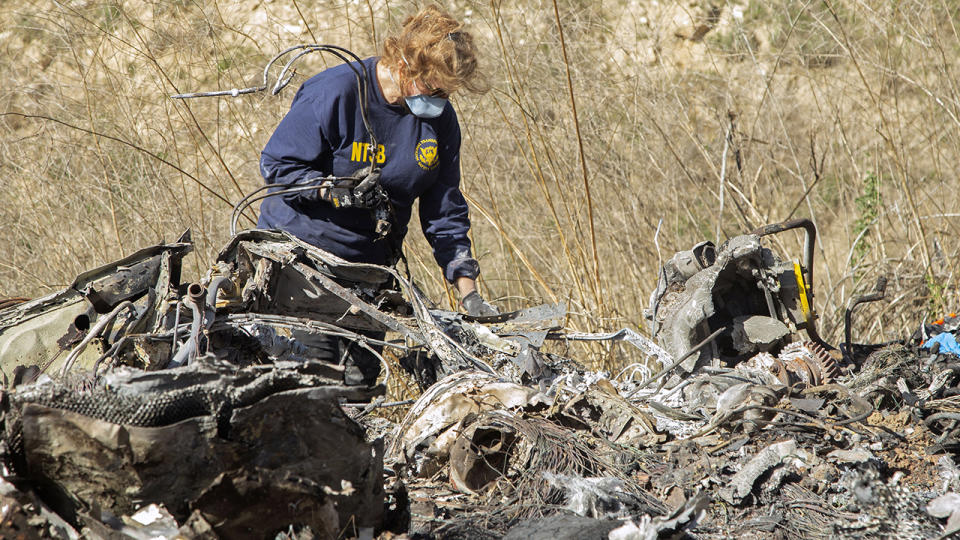'Not certified': Disturbing new details about helicopter in Kobe Bryant tragedy
The company whose helicopter crashed and killed basketball star Kobe Bryant, his daughter and seven others on Sunday was not certified to fly in foggy conditions requiring pilots to use only cockpit instruments, US officials said on Friday.
Island Express Helicopters, which owned the Sikorsky S-76B that crashed, was limited to operating under visual flight rules, meaning pilots must be able to see clearly outside the aircraft in daylight, said Keith Holloway, a National Transportation Safety Board spokesman.
‘TERRIBLE’: Senior reporter suspended over Kobe Bryant mistake
“The preliminary information is Island Express's 135 certificate did not allow for IFR flight,” Holloway said.
“No other specifics are available at this time.”
The aircraft was equipped for instrument flying, however, multiple media reports said.
“There is only one way you can be in the clouds, on an IFR flight plan or by accident," Kurt Deetz, a pilot and former safety manager with the company, told the New York Times, referring to instrument flight rules.

Holloway told Reuters on Friday that it was unknown if the pilot was in fact flying on instruments at the time of the wreck. He said a preliminary report on the crash, expected in about 10 days, may include such a determination.
The helicopter's pilot, Ara Zobayan, was licensed for instrument flying, but likely had little experience in doing so given the company's operating limitations, Deetz told Forbes separately.
The twin-engine helicopter slammed into a hillside in Calabasas, California, with clouds and fog limiting visibility.
Air traffic controllers had given Zobayan “special visual flight rules,” or clearance to fly in the less-than-optimal weather around the Burbank airport.
The pilot had reported that conditions were sufficient for visual flight, the Times said, adding that the weather appeared to have worsened as the flight continued.
In a separate statement, Island Express said it was suspending all services.
“The shock of the accident affected all staff, and management decided that service would be suspended until such time as it was deemed appropriate for staff and customers,” the charter company said.

The death of Bryant, 41, an 18-time NBA all-star and one of the most admired athletes around the globe, sent shockwaves through the sports and entertainment worlds.
Helicopter didn’t have terrain alert system
The NTSB also announced on Tuesday that the helicopter wasn’t equipped with the Terrain Awareness and Warning System (TAWS) that could have alerted the pilot that he was approaching the hillside before the crash.
“Certainly, TAWS could have helped to provide information to the pilot on what terrain the pilot was flying in,” NTSB representative Jennifer Homendy said on Tuesday.
It’s not clear if the presence of TAWS would have prevented the crash.
Homendy said that the NTSB recommended in 2006 that all helicopters capable of carrying six or more passengers be equipped with TAWS after a Sikorsky S-76A crash in the Gulf of Mexico claimed 10 lives.
She said that it wasn’t a legal requirement after the Federal Aviation Administration didn’t follow the recommendation.
History of crashes with Island Express Helicopters
Multiple reports have cited NTSB records pointing to three previous crashes of helicopters operated by Island Express since 1985. Prior to Sunday, the company had not experienced a crash since 2008.
Three people were killed and three others injured when an engine failure on an Island Express helicopter prompted an emergency landing on Catalina Island off the coast of Southern California in 2008, according to records.
In 1999, another Island Express helicopter crash landed on Catalina Island because of engine failure, resulting in one major and six minor injuries.
Six people were injured on an Island Express-operated helicopter that collided with a Helitrans Helicopter over the Pacific Ocean in 1985. One person died and five were injured on the Helitrans helicopter, according to the Long Beach Press-Telegram.
A preliminary NTSB report into Sunday’s crash is expected next week.
With Yahoo Sports Staff
